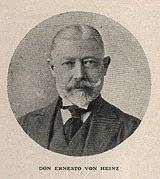| Hamilton | << = = | The Early Settlers of the Country Ernesto von Heinz |
= = >> | Henstock |

Born in Ohian, Silesia (Germany) he came to Argentina in October 1893. In his native land devoted his youth to agriculture and there he met his cousin Hermann Eberhardt, a captain in the German merchant marine, of whom we have already made mention, and who had gone back to Germany with the object of visiting his fatherland.
Eberhardt persuaded von Heinz to go to Patagonia, alluring him with the plan of an expedition of Seno de Ultima Esperanza and the adjacent lands, the beauties and attractions of which he heightened with such enthusiasm as would move the most indifferent.
Shortly after, Mr. Ernest von Heinz left his country in order to go directly to Isthens Bay, in Smith Channel. There he met with Eberhardt, and, in a steamer launch which the latter had brought out from Europe, they started the series of their adventurous and interesting excursions. In one carried out by them through the Seno de Ultima Esperanza, they found the celebrated cave of Mylodon, situated on Chilian soil, and within it, nearly buried in the ground, they discovered the skin of that prehistoric animal. Mr. von Heinz presented it to Frigate captain Mascarello, who at that time was commander of the advice-boat "Azopardo".
Some time after this find, a commission composed of the famous explorer Nordenskjold and some other persons, came to the place named, besides another commission sent by La Plata Museum, directed by Dr. Hautshal. After some excavations made by these commissions in the place where the skin had been found, they discovered the bones of the animal to which it belonged, reckoning that it was an example of the species denominated Crypotherium.
In the year 1897, Mr. von Heinz stocked some land near "Rospentek", which is that now belonging to the stations "La Fermina" and "Punta Alta".
Subsequently, he did the same at Palique, in partnership with Mr. Rudolph Stubenrauch, but in 1906, they sold the establishment to the "Explotadora Company of Tierra del Fuego", removing them to the lands to-day occupied by the station "Tapi-Aike".
Source: «La Patagonia Argentina», p.146